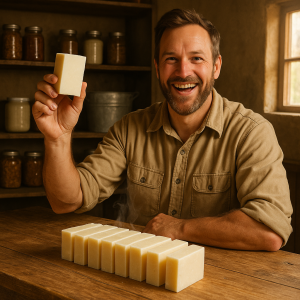
How to make bar soap
There’s something wildly satisfying about slapping a bar of homemade soap on the counter and saying, “Yep, I made that.” It’s like pulling a rabbit out of a hat, except the rabbit smells like lavender and doesn’t poop on your carpet. And in a crisis? That humble bar isn’t just about hygiene—it’s trade, dignity, and survival wrapped into one solid hunk.
Making bar soap may sound like wizardry—lye, fat, saponification (say that three times fast)—but once you understand the basics, you’ll realize soap-making is less Hogwarts and more Home Ec with a rebellious streak.
Soap 101: The Science Without the Snooze
Soap is made when lye (sodium hydroxide) and fats/oils have a meet-cute, react together, and form something new: saponification. Think of it like a blind date that ends in marriage. Alone, lye will burn a hole through your countertop. Alone, fats will clog your arteries. But together? They make soap.
The Simplest Recipe for Bar Soap
Here’s a no-frills recipe that’s perfect for laundry, dishes, or your end-of-the-world bath-time routine:
Ingredients:
-
16 oz (1 lb) lard, tallow, or coconut oil (or a mix)
-
6 oz water (distilled if possible)
-
2.3 oz lye (sodium hydroxide)
-
Optional: essential oils, dried herbs, or oatmeal for a fancy touch
Tools (a.k.a. “don’t use these again for food”):
-
A heatproof pitcher or glass jar (for lye)
-
A stainless steel or enamel pot (no aluminum—it reacts with lye)
-
A stick blender or whisk (unless you love stirring for hours)
-
Soap mold (can be as simple as a cardboard box lined with parchment)
-
Safety gear: gloves, goggles, long sleeves—lye is not your friend until it’s soap
Step-by-Step
-
Suit Up. Channel your inner mad scientist: goggles, gloves, long sleeves. Lye is serious business until it’s transformed.
-
Mix the Lye Solution. Slowly add lye to water (NEVER the other way around unless you want a kitchen volcano). It’ll heat up fast. Let it cool to about 100–120°F.
-
Heat the Oils. Melt your lard/tallow/oil in your pot and also let them cool to 100–120°F.
-
Combine. When both the lye solution and oils are in the same temp range, pour the lye into the oils.
-
Blend to Trace. Stick blend until the mixture looks like thin pudding. This stage is called “trace.”
-
Add Extras. Toss in essential oils, oatmeal, or herbs if you’re feeling like Martha Stewart meets Mad Max.
-
Pour & Rest. Pour into your mold, cover with a towel, and let it sit 24–48 hours until solid.
-
Cut Bars. Pop it out, slice into bars, and line them up like little soldiers.
-
Cure. Let the bars cure on a shelf with good airflow for 4–6 weeks. This lets excess water evaporate, making the soap harder and longer lasting.
Why Bar Soap Wins in a Crisis
-
Storage Friendly: Bars are compact and last practically forever.
-
Barter Value: Small, portable, and universally needed.
-
Customizable: From plain lard soap to rosemary-lavender spa vibes, you control the formula.
-
Sanity Saver: Nothing resets morale like smelling clean after a day of hauling buckets.
Learning to make bar soap is one of those preparedness skills that pays dividends in any reality. It’s not just about scrubbing dirt off your hands; it’s about scrubbing away the feeling that you’re helpless. With one bar of soap, you’ve created something useful, tradable, and restorative. And when everyone else is wondering why they smell like regret and raccoon cages, you’ll be holding up your sudsy trophy saying, “Clean never goes out of style.”



1 Comment
Lucy Stern · October 2, 2025 at 11:40 am
Thanks for posting abd explaining, in easy terms, how to do this . You have just encouraged me to give it a try..
Comments are closed.